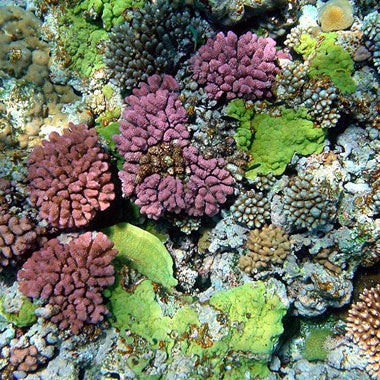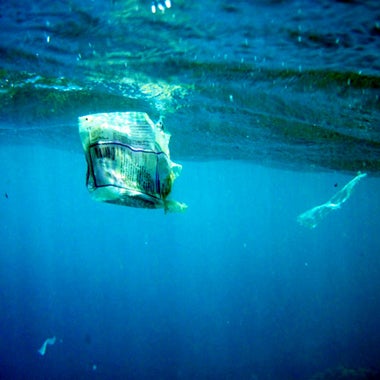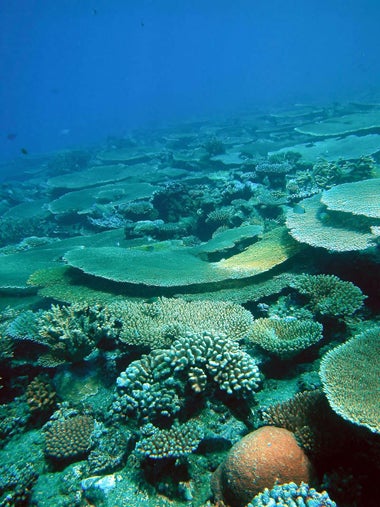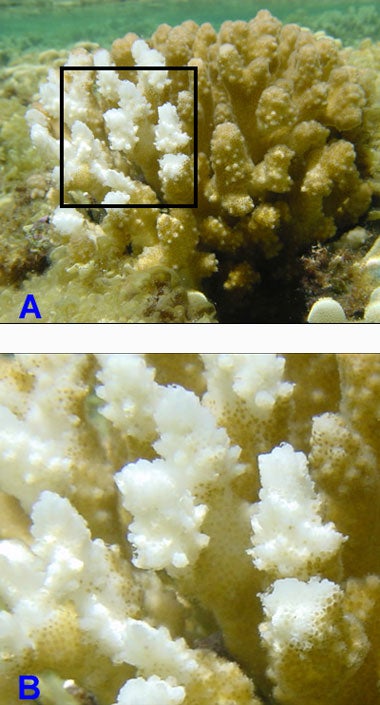How Sensitive To Changes In Water Temperature Are Coral Reefs

Corals in a reef near Papua New Republic of guinea in the Southwest Pacific. Colors are largely due to different varieties of algae living symbiotically within reef corals, and other types of algae that help bind the reef framework together.
Credit: Brocken Inaglory
A coral reef is like an underwater city. Corals and algae construct the framework that rises off the tropical ocean floor and attract a variety of inhabitants. Schools of multicolored fish glide in a higher place the structure. Invertebrates dart effectually on its surface. All that busy action and life exists in a fragile balance. Just some reefs have been so difficult striking by environmental changes that they will not recover: scientists predict that over one-half of the earth'southward coral reefs may die by 2050 if current pressures continue to threaten reefs.
Fifty-fifty though human populations live on state and coral reefs alive in the body of water, the health of coral reefs is threatened by humans in many ways. Some of the threats are easy to see - plastic bottles and other trash litter many reefs, for instance, especially those offshore from towns and cities. Sediment in the water tin clog the filters of corals and water pollution can besides be problematic. Overfishing and invasive species like lionfish are depleting the numbers of grazing fish in some areas. And scratches on corals from the fins of careless snorkelers, anchors, or fifty-fifty deep gouges from boats that have run aground are visible in many reefs.
Coral diseases, caused past sure bacteria, fungi, and viruses, occur naturally but scientists suspect that the increase in disease is due to pollution and other changes to the environment. There are more diseased corals today than in that location were several decades ago.
How is climate change involved with the health of coral reefs? First, some of the carbon dioxide discharged into the atmosphere from burning fossil fuels makes its way into the ocean, causing body of water water to become more acidic. Living in acidic water is tough for corals and other animals. Second, as Globe'southward temperature rises, much of that heat winds up in the ocean which poses a threat to the health of coral reefs. Read on for more than information most acidification and warming of sea h2o.

Climate change is one of many factors causing modify in coral reefs. Pollution in marine environments, including plastic bags similar this one in the waters of Papahanaumokuakea Marine National Monument, Hawaii, is one of those factors.
Credit: Wesley Byers/Papahanaumokuakea, Hi
Acidic Ocean Water
As the concentration of the greenhouse gas carbon dioxide increases in the temper, largely from burning fossil fuels, some of it gets dissolved into bounding main h2o. This changes the chemical science of seawater, lowering its pH, making it more acidic. Acidic water makes information technology difficult for coral and algae to build the reef framework.
Marine creatures such every bit corals, clams, snails, and many types of algae and plankton build their skeletons and shells from calcium carbonate (limestone). These creatures get the chemical building blocks they need for construction from seawater. Some, similar algae, passively collect these building blocks. Others have a more deliberate machinery for getting the calcium ions and carbonate ions from seawater. As seawater gets more acidic with more carbon dioxide dissolved in information technology, these creatures have a harder time making their skeletons and shells.
Calcium carbonate mineral dissolves in acid. Try it out for yourself. Put a clam shell (ane that you don't want to keep) into a container of vinegar and look. While a pH of 7 is neutral, vinegar has a pH of 3 so it is an acrid. Within a few hours its surface will get pitted with tiny dimples that you can see with a magnifying glass. Over a day or two you will notice that your mollusk vanquish is disappearing. The calcium carbonate that makes up the shell dissolves into the acidic vinegar.
Seawater's pH is non dropping every bit low as vinegar. The pH of seawater varies between 7 and viii, so it is a little more basic than neutral. Since the start of the Industrial Revolution, pH of seawater has dropped about 0.1. In the next century information technology is expected to drop another 0.1-0.35. Just scientists doubtable that even these small changes can make a big deviation.

Healthy corals on Australia's Great Bulwark Reef, the largest reef in the world. (Prototype: UNC)
"We are simply beginning to understand the complex interactions between large-scale chemistry changes and marine ecology," said Joanie Kleypas, scientist at the National Center for Atmospheric Inquiry in Boulder, CO. This is an surface area of active research.
Because reef corals build massive structures from calcium carbonate, and because those structures get a home to diverse communities of marine life, the impact of increasing acidification on corals is of particular involvement to many scientists. Current inquiry indicates that for a doubling of the partial pressure of carbon dioxide (pCO2), rates of calcification decreased in corals an average of xxx%. The charge per unit is affected by many other factors likewise the concentration of CO2 dissolved in the water. The temperature, light, and nutrients all affect calcification rates, too. Lower rates of calcification volition likely impact marine food webs, possibly changing the biodiversity of the bounding main.
"This threat is hitting coral reefs at the same time that they are being hit by warming-induced mass bleaching events," said Chris Langdon, a University of Miami scientist. Coral reefs are currently responding to many other threats such as warmer water, overfishing, and coral diseases, so the furnishings might be worse.
Warming Ocean Water
Every bit the Globe warms, oestrus makes its way into the body of water. While most corals alive in the warmth of the torrid zone, the water can become also warm for them. When waters rut up, corals get stressed and go through a procedure called bleaching which makes them expect as white as their skeletons. In fact, bleaching makes the corals transparent, and so their white appearance actually is their skeletons.
To sympathize how coral tin can plough equally white equally a ghost, it'south helpful to think about what makes up healthy coral. A colony of coral is made up of hundreds, or fifty-fifty thousands, of individual coral animals. Each coral animal, which is much like a tiny upside-down jellyfish planted in a rocky skeleton, has algae living inside its body called zooxanthellae. The algae, through the process of photosynthesis, make their own food with help from sunlight streaming through the articulate, tropical bounding main water. The algae produce more food than they demand. Corals consume the leftovers. And the corals offer the algae a squeamish place to live. Information technology's an example of symbiosis, a relationship on nature that's beneficial to both.

Partially bleached coral colony (Pocillipora sp.) on a Pacific reef (A). Areas that have expelled symbiotic algae appear white. Close view of bleached area (B). Private coral animals within the colony that even so have some of their symbiotic algae are visible every bit xanthous-brown spots.
Credit: NOAA
However, during times of environmental stress, the coral animals will release the colorful algae from their tissues, which is what causes the coral to appear white. Corals bleach for a number of reasons (and scientists are studying coral bleaching to better understand what causes information technology) just one of the principal triggers is unusually warm seawater. Corals are very sensitive to changes in temperature. H2o that warms only one caste Celsius can cause corals to bleach. The ocean is warming equally climate changes, and, thus, the corporeality of bleached corals is expected to go more pronounced. Plus, the part of the ocean that warms the almost is the sea surface and most reef corals live quite near the body of water surface.
There are other reasons that corals bleach. Corals may bleach if salinity changes, if in that location are loftier levels of solar radiations (typically during summer), if the reef is in the path of a big tempest, if there is pollution in the water, or if sediment runoff from state makes its way to the reef. While bleaching is a natural reaction, information technology has go more mutual equally human impacts on the bounding main accept grown. Some species of coral are more susceptible to bleaching than others. In general, coral species that grade branching, tree-like colonies are more susceptible to bleaching than coral species that form circular, boulder-like colonies. Some species of the algae are more sensitive to ecology stress too.
Bleaching weakens the coral animals. In one case bleached, many corals can not recover. Without the algae, the bleached corals accept less nutrition. They are able to take hold of and swallow plankton, but this is not as much food as they are used to having. If the stressful conditions terminate, corals can take more algae into their tissues and regain their health. If the stressful weather continue, the corals are likely to die.
Thousands of other organisms call coral reefs abode – from large sharks and rays to tiny shrimp and worms. If most of the corals on a reef bleach (in what is chosen a "mass-bleaching consequence") and so die, this tin can impact the survival of creatures that rely on the reef - either directly past feeding on corals or indirectly by relying on the reef structure for habitat.
As tropical waters continue to warm, coral reefs will bleach more often than they are able to handle without long-term damage or expiry. Bleaching events have already had a large impact on many reefs and volition likely become more frequent in the future. This volition reduce coral cover and diverseness on reefs over the side by side few decades, although hopeful contempo inquiry suggests that some of the world's reefs might exist protected if areas of the ocean are able to maintain a desirable temperature range.
Source: https://scied.ucar.edu/learning-zone/climate-change-impacts/corals-and-climate

0 Response to "How Sensitive To Changes In Water Temperature Are Coral Reefs"
Post a Comment